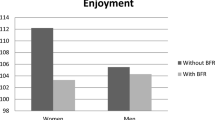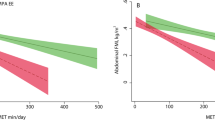Abstract
Following periods of physical activity, it is not uncommon for exercisers to increase their energy intake as a reward deemed ‘earned’. Consumers’ awareness of the energy within food and expended from exercise has previously been found to be limited. Therefore, the aim was to investigate whether habitual exercisers (50 adults and 49 children from 5 sports clubs) were able to conceptualise the energy expenditure (EE), following 1 h of their regular sports training, into a quantifiable amount of perceived energy compensation (PEC) in the form of food (chocolate) or drink (sports drink). Mean percentage accuracy for the PEC against EE matched <30% (±29%), a significant underestimation irrespective of sex or sport. Percentage accuracy failed to significantly correlate to age. These findings indicate a necessity to improve nutrition education surrounding the energy costs of exercise relative to the energy contained within foods/drinks for both adults and children.
This is a preview of subscription content, access via your institution
Access options
Subscribe to this journal
Receive 12 print issues and online access
$259.00 per year
only $21.58 per issue
Buy this article
- Purchase on Springer Link
- Instant access to full article PDF
Prices may be subject to local taxes which are calculated during checkout


Similar content being viewed by others
References
Department of Health. Dietary reference values for food energy and nutrient for the United Kingdom: report of the panel on dietary reference values 1991, Report on Health and Social Subjects No 41, DH: HMSO.
Finlayson G, Caudwell P, Gibbons C, Hopkins M, King N, Blundell J . Low fat loss response after medium-term supervised exercise in obese is associated with exercise-induced increase in food reward. J Obes 2011; pii Article ID 615624.10.1155/2011/615624.
Dohle S, Wansink B, Zehnder L . Exercise and food compensation: exploring diet-related beliefs and behaviors of regular exercisers. J Phys Act Health 2014; 12: 322–327.
Ainsworth BE, Haskell WL, Herrmann SD, Meckes N, Bassett DR, Tudor-Locke C et al. 2011 Compendium of physical activities: a second update of codes and MET values. Med Sci Sports Exerc 2011; 43: 1575–1581.
Ridley K, Ainsworth BE, Olds TS . Development of a compendium of energy expenditures for youth. Int J Behav Nutr Phys Act 2008; 5: 45.
Acknowledgements
JLV-C’s work has been funded by a project grant from Kellogg’s Ltd.
Author information
Authors and Affiliations
Corresponding author
Ethics declarations
Competing interests
The authors declare no conflicts of interest.
Additional information
DISCLAIMER
The results of the study do not constitute endorsement of Kellogg’s Ltd.
Rights and permissions
About this article
Cite this article
Varley-Campbell, J., Moore, M., Ewen, R. et al. Perceived energy compensation following various sports: an age and sex comparison. Preliminary observations. Eur J Clin Nutr 69, 1344–1345 (2015). https://doi.org/10.1038/ejcn.2015.108
Received:
Revised:
Accepted:
Published:
Issue Date:
DOI: https://doi.org/10.1038/ejcn.2015.108



